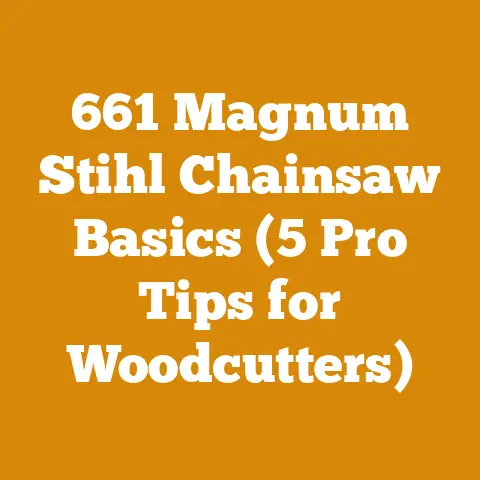266 XP Husqvarna Specs Compared (5 Pro Tips for Saw Performance)
It’s incredibly frustrating when you’re out in the field, ready to tackle a tough logging job, and your chainsaw just isn’t performing.
You’ve got deadlines looming, wood to process, and a saw that feels like it’s working against you.
I’ve been there countless times, wrestling with temperamental equipment, and it’s not just the physical strain, it’s the financial hit from lost productivity.
That’s why understanding your chainsaw inside and out, especially a workhorse like the Husqvarna 266 XP, is absolutely crucial.
In this article, I’m going to dive deep into the 266 XP, comparing its specs to its contemporaries and, more importantly, sharing five pro tips to ensure you’re getting peak performance from this legendary saw.
We’ll also tackle the often-overlooked but vital topic of budgeting for chainsaw operation, maintenance, and the overall costs involved in wood processing.
Husqvarna 266 XP: A Legend Analyzed
The Husqvarna 266 XP is a chainsaw that’s earned its stripes through years of reliable service in demanding environments.
Let’s break down the core specifications that define this saw:
- Engine Displacement: 66.7 cc (4.07 cu. in.)
- Power Output: 3.6 kW / 4.8 hp
- Weight (excluding bar and chain): 6.1 kg / 13.4 lbs
- Recommended Bar Length: 13″ – 28″ (33 cm – 71 cm)
- Fuel Tank Volume: 0.7 liters / 23.7 fl. oz
- Oil Tank Volume: 0.4 liters / 13.5 fl. oz
- Chain Pitch: .325″ or 3/8″
- Chain Gauge: .050″ / 1.3 mm
These specs tell a story of a saw built for power and durability.
The 66.7cc engine provides ample torque for felling medium to large trees and bucking firewood.
The weight, while not the lightest in its class, is manageable for extended use, especially when balanced with the right bar length.
Compared to the Competition: A Head-to-Head
To truly appreciate the 266 XP, let’s see how it stacks up against some of its contemporaries and modern alternatives:
As you can see, the 266 XP, despite its age, holds its own in terms of power and weight compared to later models.
The Stihl MS 361, a direct competitor, offers similar performance, while the Husqvarna 562 XP and Stihl MS 362 C-M represent advancements in engine technology and ergonomics.
However, the 266 XP’s simplicity and robust design contribute to its enduring appeal.
The Cost Factor: Old vs. New
When considering a chainsaw, the initial purchase price is just the tip of the iceberg.
Let’s delve into the cost differences between buying a used 266 XP versus a new, comparable saw:
- Used Husqvarna 266 XP: $200 – $500 (depending on condition)
- New Husqvarna 562 XP: $800 – $1000
- New Stihl MS 362 C-M: $850 – $1100
While a used 266 XP can be a budget-friendly option, remember to factor in potential repair costs.
Older saws may require new parts, such as carburetors, fuel lines, or ignition modules.
I’ve personally spent more than the initial purchase price on restoring vintage saws, so due diligence is key.
5 Pro Tips for Maximizing 266 XP Performance
The Husqvarna 266 XP is a capable machine, but like any tool, its performance depends on proper maintenance and technique.
Here are five pro tips to help you get the most out of your saw:
- Fuel Mixture is King: The 266 XP, being a two-stroke engine, relies on a precise fuel-to-oil mixture.
I always recommend using a high-quality two-stroke oil at the manufacturer’s recommended ratio (typically 50:1).
Using the wrong ratio or cheap oil can lead to engine damage and reduced performance.
I’ve seen firsthand the damage caused by improper fuel mixtures – scored pistons, clogged carburetors, and ultimately, a useless saw.
Always mix your fuel fresh and use a fuel stabilizer if you’re storing it for more than a few weeks. - Sharpen Your Chain Religiously: A dull chain is not only inefficient but also dangerous.
It puts extra strain on the engine, increases the risk of kickback, and produces more sawdust than chips.
I sharpen my chains after every tank of fuel, or more frequently if I’m cutting dirty or abrasive wood.
Learn to file your chain correctly using a file guide, or invest in a chain grinder for faster and more consistent sharpening. - Keep the Air Filter Clean: The air filter protects the engine from dust and debris.
A clogged air filter restricts airflow, leading to reduced power and increased fuel consumption.
I clean my air filter after every use, either by brushing it off or washing it with soap and water (allowing it to dry completely before reinstalling).
Consider upgrading to a high-performance air filter for improved filtration and airflow. - Master Carburetor Tuning: The carburetor controls the air-fuel mixture entering the engine.
Proper carburetor tuning is essential for optimal performance.
The 266 XP typically has three adjustment screws: “L” (low speed), “H” (high speed), and “T” (idle speed).
Tuning a carburetor can be tricky, but there are plenty of resources available online and in chainsaw repair manuals.
Start by adjusting the “L” and “H” screws to achieve a smooth idle and maximum power at full throttle.
Then, adjust the “T” screw to set the correct idle speed.
If you’re unsure, consult a qualified chainsaw technician. - Regular Maintenance is Non-Negotiable: Preventative maintenance is key to extending the life of your 266 XP.
This includes regularly inspecting and cleaning the spark plug, replacing fuel lines and filters, lubricating the bar and chain, and checking the clutch and brake.
I recommend performing a thorough inspection and maintenance check at least once a year, or more frequently if you use the saw heavily.
Budgeting for Wood Processing: Beyond the Chainsaw
Owning a chainsaw is just one piece of the wood processing puzzle.
To accurately budget for your projects, you need to consider all the associated costs.
Let’s break down the key components:
1. Timber Acquisition Costs
- Standing Timber Purchase: If you’re harvesting trees from your own property, you may not have a direct purchase cost.
However, if you’re buying standing timber from a landowner, the price will vary depending on the species, size, quality, and location of the trees.
Timber prices are typically quoted per board foot (BF) or per thousand board feet (MBF).
According to recent reports from forestry agencies, softwood timber prices in North America range from $200 to $600 per MBF, while hardwood timber prices can range from $500 to $1500 per MBF, or even higher for premium species like black walnut or cherry. - Harvesting Permits and Regulations: Depending on your location, you may need permits to harvest timber, especially on public lands.
These permits can range from a few dollars to several hundred dollars, depending on the size of the harvest and the complexity of the regulations.
I always check with my local forestry agency before starting any logging project to ensure I’m in compliance with all applicable laws and regulations. - Logging Insurance: If you’re hiring a logging crew, you’ll need to ensure they have adequate insurance coverage, including workers’ compensation and liability insurance.
Logging is a hazardous profession, and insurance is essential to protect yourself from potential financial losses.
2. Labor Costs
- Logging Crew Wages: If you’re hiring a logging crew, their wages will be a significant expense.
Logging crew wages vary depending on the location, experience, and skill level of the workers.
According to data from the U.S.
Bureau of Labor Statistics, the median hourly wage for logging workers in May 2023 was $22.50.
However, wages can range from $15 per hour for entry-level workers to $35 per hour or more for experienced fallers and equipment operators. - Your Own Labor: Don’t forget to factor in the value of your own time.
Even if you’re not paying yourself an hourly wage, your time is valuable.
Consider how much time you’ll be spending on each task, from felling trees to splitting firewood, and estimate the opportunity cost of that time.
What else could you be doing with those hours?
3. Equipment Costs
- Chainsaw Purchase and Maintenance: As we discussed earlier, the initial cost of a chainsaw is just the beginning.
You’ll also need to budget for ongoing maintenance, including chain sharpening, parts replacements, and fuel and oil.
I typically budget 10-15% of the chainsaw’s purchase price per year for maintenance. - Other Logging Tools: In addition to a chainsaw, you’ll need other logging tools, such as axes, wedges, felling levers, and log tongs.
These tools can range in price from a few dollars to several hundred dollars each. - Log Splitter: If you’re processing firewood, a log splitter can save you a lot of time and effort.
Log splitters range in price from a few hundred dollars for a manual splitter to several thousand dollars for a hydraulic splitter.
Renting a log splitter can be a cost-effective option if you only need it occasionally.
Rental rates typically range from $50 to $100 per day. - Transportation Costs: Transporting logs and firewood can be a significant expense, especially if you’re hauling them long distances.
You’ll need to factor in the cost of fuel, vehicle maintenance, and potentially, rental fees for a truck or trailer. - Safety Gear: Safety gear is essential for protecting yourself from injury while logging or processing firewood.
This includes a helmet, eye protection, hearing protection, gloves, chaps, and steel-toed boots.
I never skimp on safety gear – it’s an investment in my health and well-being.
4. Processing and Drying Costs
- Firewood Splitting and Stacking: Splitting and stacking firewood can be a labor-intensive task.
If you’re hiring someone to do it for you, expect to pay $50 to $100 per cord, depending on the location and the complexity of the job. - Drying Time and Storage: Firewood needs to be properly dried before it can be burned efficiently.
The drying time varies depending on the species of wood, the climate, and the stacking method.
Generally, firewood needs to be dried for at least six months, and preferably a year or more.
You’ll need a dry, well-ventilated place to store your firewood.
5. Hidden Costs
- Unexpected Repairs: Chainsaws and other logging equipment can break down unexpectedly.
It’s always a good idea to set aside a contingency fund to cover unexpected repairs. - Weather Delays: Inclement weather can delay logging or firewood processing projects.
This can lead to increased labor costs and missed deadlines. - Tool Depreciation: The value of your logging tools will depreciate over time.
This is an important factor to consider when calculating the long-term cost of wood processing.
Case Study: Budgeting for a Cord of Firewood
Let’s walk through a hypothetical case study to illustrate how to budget for a cord of firewood:
Scenario: You want to produce one cord of seasoned firewood from standing timber on your property.
Assumptions:
- You own the land and have the right to harvest timber.
- You’ll be doing all the work yourself.
- You already own a Husqvarna 266 XP chainsaw and other basic logging tools.
- The timber is easily accessible and requires minimal transportation.
Cost Breakdown:
- Timber Value (Opportunity Cost): $50 (This represents the potential value of the timber if you were to sell it instead of using it for firewood.)
- Chainsaw Fuel and Oil: $20
- Chainsaw Chain Sharpening: $5
- Log Splitter Rental (1 day): $75
- Transportation (Fuel): $10
- Your Labor (16 hours at $20/hour): $320
- Total Cost: $480
Analysis:
Based on these assumptions, the cost of producing one cord of firewood is $480.
This is significantly higher than the average price of a cord of seasoned firewood, which typically ranges from $200 to $400, depending on the location and the species of wood.
However, this analysis doesn’t factor in the value of your time and effort, or the satisfaction of producing your own firewood.
Cost Optimization Tips:
- Reduce Labor Costs: Use a more efficient log splitter or hire someone to help you split and stack the firewood.
- Minimize Transportation Costs: Process the firewood as close to the source as possible.
- Maximize Efficiency: Sharpen your chainsaw chain regularly and maintain your equipment in good working order.
- Sell Excess Firewood: If you produce more firewood than you need, consider selling the excess to offset your costs.
Global Timber Price Benchmarks
Understanding global timber price benchmarks is crucial for anyone involved in wood processing, whether you’re a small-scale logger or a large-scale timber company.
Here’s a brief overview of timber prices in different regions:
- North America: As mentioned earlier, softwood timber prices in North America range from $200 to $600 per MBF, while hardwood timber prices can range from $500 to $1500 per MBF.
Prices vary depending on the species, quality, and location of the timber. - Europe: Timber prices in Europe are generally higher than in North America, due to stricter forestry regulations and higher labor costs.
According to data from the European Commission, the average price of softwood timber in Europe in 2023 was €100-€150 per cubic meter, while the average price of hardwood timber was €150-€250 per cubic meter. - Asia: Timber prices in Asia vary widely depending on the country and the species of wood.
In China, the world’s largest importer of timber, softwood timber prices range from $150 to $300 per cubic meter, while hardwood timber prices can range from $300 to $500 per cubic meter or higher. - South America: South America is a major exporter of timber, particularly tropical hardwoods.
Timber prices in South America are generally lower than in other regions, due to lower labor costs and less stringent forestry regulations.
However, prices are rising as demand for sustainable timber increases.
These are just general benchmarks, and actual timber prices can vary significantly depending on a variety of factors.
It’s always a good idea to consult with local timber buyers and forestry experts to get the most accurate pricing information for your specific region.
Actionable Takeaways and Next Steps
Budgeting for wood processing or firewood preparation can seem daunting, but by breaking down the costs into individual components and considering all the relevant factors, you can create a realistic and accurate budget.
Here are some actionable takeaways and next steps:
- Assess Your Needs: Determine the scope of your project and the amount of wood you need to process.
- Research Timber Prices: Get accurate pricing information for the species and quality of timber you need.
- Estimate Labor Costs: Factor in the cost of your own labor and any hired help.
- Inventory Your Equipment: Determine what equipment you already own and what you need to purchase or rent.
- Create a Detailed Budget: Break down all the costs into individual line items and estimate the total cost of your project.
- Track Your Expenses: Monitor your expenses throughout the project and make adjustments as needed.
- Optimize Your Costs: Look for ways to reduce your costs without compromising safety or quality.
By following these steps, you can effectively budget for your wood processing or firewood preparation projects and ensure that you stay on track and within your budget.
Remember, “a penny saved is a penny earned,” and careful budgeting can help you maximize your profits and minimize your risks.
The Husqvarna 266 XP, with proper care and maintenance, can be a valuable asset in your wood processing endeavors, helping you to get the job done efficiently and effectively.
Now, go out there and make some sawdust!






